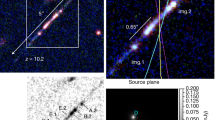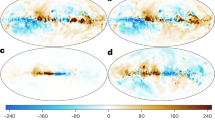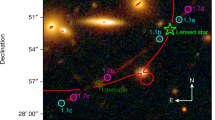Abstract
Although a static lens can produce no change in the brightness of an isotropic radiation field, a moving lens produces a characteristic two-sided brightness pattern that may be used to deduce the transverse velocity of the lens. The magnitude of the effect is proportional to both the transverse velocity and the strength of the lens. We suggest here that this effect provides a method for measuring the transverse velocities of clusters of galaxies; in this case the lens is gravitational and the radiation field is the isotropic microwave background. The predicted magnitude of this effect is at the present sensitivity limits of observation but is at least as large as the expected level of primordial background fluctuations.
This is a preview of subscription content, access via your institution
Access options
Subscribe to this journal
Receive 51 print issues and online access
$199.00 per year
only $3.90 per issue
Buy this article
- Purchase on SpringerLink
- Instant access to full article PDF
Prices may be subject to local taxes which are calculated during checkout
Similar content being viewed by others
References
Birkinshaw, M., Gull, S. F. & Northover, K. J. E. Mon. Not. R. astr. Soc. 197, 571–592 (1981).
Boynton, P. E. Proc. IAU Symp. No. 79, 317–324 (1978).
Author information
Authors and Affiliations
Rights and permissions
About this article
Cite this article
Birkinshaw, M., Gull, S. A test for transverse motions of clusters of galaxies. Nature 302, 315–317 (1983). https://doi.org/10.1038/302315a0
Received:
Accepted:
Issue date:
DOI: https://doi.org/10.1038/302315a0
This article is cited by
-
Line-intensity mapping: theory review with a focus on star-formation lines
The Astronomy and Astrophysics Review (2022)
-
A space mission to map the entire observable universe using the CMB as a backlight
Experimental Astronomy (2021)
-
Diagnostic properties of moving gravitational lenses
Nature (1989)
-
The brightness of a black hole due to gravitational lensing
Astrophysics and Space Science (1989)



